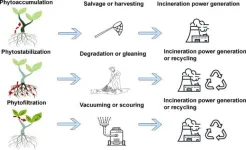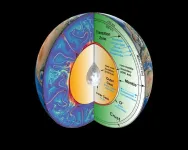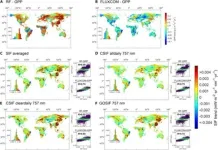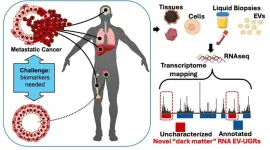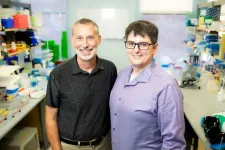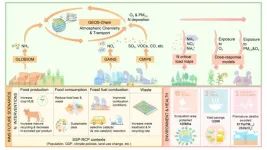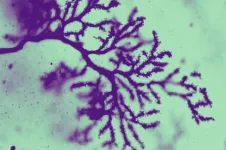(Press-News.org) In an innovative ecological article, researchers have unveiled the potential of phytoremediation to curb microplastic pollution. This approach leverages natural plant processes to absorb and diminish micro and nanoplastics, offering a viable solution for managing environmental plastic pollution. This viewpoint advocates utilizing plant life as an effective tool against the widespread issue of plastic contamination in ecosystems.
With escalating concerns about the enduring impact of plastic waste, phytoremediation emerges as a promising solution. This method utilizes plants to capture and degrade pollutants, providing an environmentally friendly and cost-effective alternative to traditional techniques. As plastics continue to inundate ecosystems worldwide, advancing phytoremediation could revolutionize our environmental management strategies. Addressing these challenges, there is an essential demand for comprehensive research to enhance and apply phytoremediation effectively.
Proposed by the Hubei Key Laboratory of Wetland Evolution & Ecological Restoration, this pivotal perspective (DOI: 10.1016/j.eehl.2024.04.001), published in Eco-Environment & Health on April 16, 2024, explores how plants can alleviate micro/nanoplastic pollution. The research identifies possible mechanisms and technological pathways for phytoremediation to combat plastic pollution, potentially delivering a sustainable solution for polluted environments across terrestrial, aquatic, and atmospheric realms.
This novel perspective evaluates the potential of different types of plants to capture, stabilize, and filter micro and nanoplastics. Targeted hyperaccumulators are expected to significantly lower plastic concentrations, thus preventing their further spread. The perspective delves into the application of phytoaccumulation, phytostabilization, and phytofiltration across diverse environmental settings. By strategically selecting and positioning these plants, they not only sequester harmful plastics but also convert them into harmless or useful forms, marking a substantial advance in sustainable plastic remediation.
Dr. Yuyi Yang, the study's lead researcher, underscores its transformative potential, stating, "Phytoremediation isn't merely a technique; it's a sustainable revolution in our battle against plastic pollution. By harnessing plant-based solutions, we are able to lessen the environmental burden of plastics, turning waste into valuable resources and fostering a healthier planet."
The study's findings are significant, advocating for the integration of phytoremediation within existing waste management frameworks to boost both efficacy and sustainability. This strategy not only reduces pollution but also aids in ecosystem recovery, enhancing biodiversity and ecological health. The research calls for expanding phytoremediation practices, highlighting the necessity for holistic strategies that encompass prevention, interception, and recycling of plastics using advanced green technologies.
###
References
DOI
10.1016/j.eehl.2024.04.001
Original Source URL
https://doi.org/10.1016/j.eehl.2024.04.001
Funding information
This work was supported by the National Natural Science Foundation of China (32201391 and 42107048) and the Special Research Assistant Project, Chinese Academy of Sciences (E1291P02). E.G.B. X acknowledges the support of the Department of Biology, University of Southern Denmark, and Danmarks Frie Forskningsfond (0165-00056B).
About Eco-Environment & Health (EEH)
Eco-Environment & Health (EEH) is an international and multidisciplinary peer-reviewed journal designed for publications on the frontiers of the ecology, environment and health as well as their related disciplines. EEH focuses on the concept of "One Health" to promote green and sustainable development, dealing with the interactions among ecology, environment and health, and the underlying mechanisms and interventions. Our mission is to be one of the most important flagship journals in the field of environmental health.
END
Green warriors: plants on the frontline against microplastics
2024-08-16
ELSE PRESS RELEASES FROM THIS DATE:
Decoding mysterious seismic signals
2024-08-16
For the decades since their discovery, seismic signals known as PKP precursors have challenged scientists. Regions of Earth’s lower mantle scatter incoming seismic waves, which return to the surface as PKP waves at differing speeds.
The origin the precursor signals, which arrive ahead of the main seismic waves that travel through Earth’s core, has remained unclear, but research led by University of Utah geophysicists sheds new light on this mysterious seismic energy.
PKP precursors appear to propagate from places deep below North America and the western Pacific and possibly bear an association with “ultra-low velocity zones,” thin layers ...
Green light for accurate vegetation research: new evaluation of global SIF datasets
2024-08-16
A recent study has pinpointed the top-performing solar-induced chlorophyll fluorescence (SIF) products for precise global monitoring of photosynthesis and vegetation dynamics. By thoroughly evaluating eight widely-used SIF datasets, the research team identified Global OCO-2 SIF (GOSIF) and Contiguous Solar-Induced Fluorescence (CSIF) as leading tools for estimating gross primary productivity (GPP) and forecasting key phenological stages. These findings provide crucial direction for scientists aiming to enhance global vegetation ...
Mount Sinai researchers discover novel nanoparticles in blood with potential to transform cancer diagnosis
2024-08-16
New York, NY [August 16, 2024]—Scientists at the Icahn School of Medicine at Mount Sinai have identified a new class of RNAs packed into tiny particles known as extracellular vesicles (EVs) that could revolutionize how cancer and other diseases are diagnosed. The team found that these molecules undergo changes when cancer is present, suggesting their potential as biomarkers for detecting prostate cancer or as targets for therapy. The work, led by Navneet Dogra, PhD, Edgar Gonzalez-Kozlova, PhD, Tzu-Yi Chen, PhD, ...
Underground event marks excavation completion on colossal caverns for underground neutrino laboratory, DUNE
2024-08-16
Lead, SD (Aug. 15, 2024) — A ribbon-cutting event was held today at the Sanford Underground Research Facility (SURF) in Lead, S.D. to mark the completion of excavation work for the Long-Baseline Neutrino Facility/Deep Underground Neutrino Experiment (LBNF/DUNE), an international project led by the U.S. Department of Energy’s Fermi National Accelerator Laboratory. The “Into the Depths of Discovery” event, hosted by Fermilab and the South Dakota Science and Technology Authority (SDSTA), was attended by supporters of the three-year excavation of the caverns, including state and federal leaders as well as officials from the Department of Energy.
“Today ...
Exposing myths about ballot collection on Native American reservations
2024-08-16
Third-party collection of mail-in ballots has helped rural residents and those with disabilities to vote, yet the practice has become contentious and the target of laws aimed at restricting it.
Critics claim the process is vulnerable to fraud and manipulation.
But new research from the University of Utah’s College of Social & Behavioral Science tells a different story. Ballot collection is more accurately characterized as a pathway for legitimate voter participation, according to a study published last month. Authors Daniel McCool, a professor emeritus in the Department of Political Science, and Weston McCool, a ...
New twist on synthesis technique developed at Rice promises sustainable manufacturing
2024-08-16
James Tour’s lab at Rice University has developed a new method known as flash-within-flash Joule heating (FWF) that could transform the synthesis of high-quality solid-state materials, offering a cleaner, faster and more sustainable manufacturing process. The findings were published in Nature Chemistry on Aug. 8.
Traditionally, synthesizing solid-state materials has been a time-consuming and energy-intensive process, often accompanied by the production of harmful byproducts. But FWF enables gram-scale production of diverse compounds in seconds while reducing energy, water consumption and greenhouse gas emissions by ...
Rare diseases point to connections between metabolism and immunity
2024-08-16
Inherited diseases of metabolism and immunity have more in common than previously recognized, according to a new study published in the journal Science Immunology. The findings point to a new set of metabolic genes that are important for the function of immune system T cells, and they offer insights that could improve care for patients with these disorders.
The study examined genes that cause inborn errors of metabolism (disorders of the processes that cells use to convert food to energy) and inborn errors of immunity (disorders that affect immune system function). These rare and complex diseases are not fully understood.
“There had previously ...
Nitrogen interventions as a key to better health and robust ecosystems
2024-08-16
The Earth’s nitrogen cycle is among the most heavily exceeded planetary boundaries. Agricultural production and fossil fuel burning release nitrogen pollutants like ammonia (NH3), nitrogen oxides (NOx), and nitrous oxide (N2O), which contribute to air pollution and damage ecosystems. These pollutants harm human health, crops, and ecosystems. Given the growing global energy and food demand, this damage is expected to increase even further.
The potential of nitrogen pollution mitigation technologies ...
Knocking out one key gene leads to autistic traits
2024-08-16
More than 70 genes have been linked to autism spectrum disorder (ASD), a developmental condition in which differences in the brain lead to a host of altered behaviors, including issues with language, social communication, hyperactivity, and repetitive movements. Scientists are attempting to tease out those specific associations gene by gene, neuron by neuron.
One such gene is Astrotactin 2 (ASTN2). In 2018, researchers from the Laboratory of Developmental Neurobiology at Rockefeller University discovered how defects in the protein produced by the gene disrupted ...
What does the EU's recent AI Act mean in practice?
2024-08-16
The European Union's law on artificial intelligence came into force on 1 August. The new AI Act essentially regulates what artificial intelligence can and cannot do in the EU. A team led by computer science professor Holger Hermanns from Saarland University and law professor Anne Lauber-Rönsberg from Dresden University of Technology has examined how the new legislation impacts the practical work of programmers. The results of their analysis will be published in the autumn.
'The AI Act shows ...
